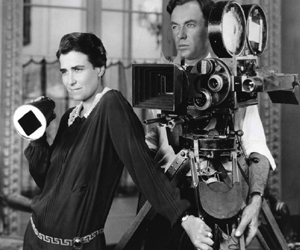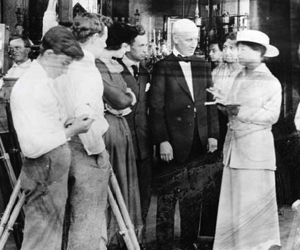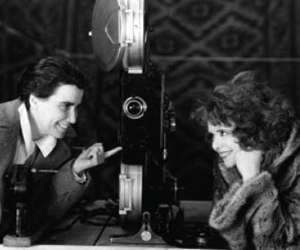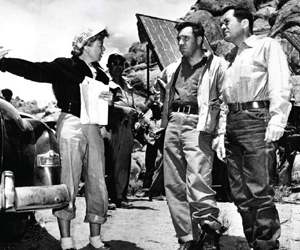BY JEANINE BASINGER
 The Right Stuff: Dorothy Arzner, with cameraman Al Gilks,
The Right Stuff: Dorothy Arzner, with cameraman Al Gilks,
on Fashions or Women (1927), managed to thrive in the
studio system. In 1937 she became the first woman
admitted to the Directors Guild.In January 2010, Kathryn Bigelow won the DGA Award as best director for her film The Hurt Locker, and, within weeks, she also received an Oscar from the Motion Picture Academy. Bigelow’s awards honored the mastery of her craft and the quality of her artistry, but they carried with them a significant second meaning. She had made motion picture history by becoming the first woman ever to win either prize. But in no way does that mean female directors hadn’t done important work before that. None of them won directorial awards, but they made their own contribution to the art of film directing. Among them are three pioneering women: Alice Guy-Blaché, Dorothy Arzner, and Ida Lupino. Each of them directed successful movies and navigated the particular challenges of her era with great talent, skill, and courage.
Alice Guy-Blaché (also known as Alice Guy) has accurately been called "the first woman film director." She was in her early 20s by the time movies were invented (the accepted date is usually 1895) and directed her first film, The Cabbage Fairy, in 1896, a date that puts her in on the ground floor by anyone’s standards. And The Cabbage Fairy is a real movie. It even featured an early “special effect” in which a picture postcard depicting a woman growing children up out of her cabbage patch suddenly comes to life.
Born in Paris in 1873, Guy-Blaché entered the movie business before it had time to shape itself into a male enterprise. Movies were not born gender specific; they were simply a new toy to be played with, and she wanted to be part of the game. After a convent education, she took a job as a secretary to French film pioneer Léon Gaumont in 1895. Since there was no established hierarchy, she could come to work, do her job and also get involved in other aspects of this exciting new invention. Guy-Blaché was efficient and imaginative, and was soon running Gaumont’s production office and helped crank out product by directing films herself.
For the record, Guy-Blaché was not the only female directing movies in the nascent days of cinema. In America, Mabel Normand, Grace Cunard, Lottie Lyell, Dorothy Davenport Reid, and even Lillian Gish, were also directing. Most notably, Lois Weber, a child prodigy who toured as a concert pianist, became a highly regarded director (she was Universal’s highest paid director in 1917) and was as well known as D.W. Griffith. Weber’s work, which influenced Dorothy Arzner, was designed largely to educate through social messages, but Guy-Blaché’s films embraced cinema as entertainment. Guy-Blaché was fearless in approaching the new medium and played with the properties of film: running in reverse, using double exposures, color tinting, bringing fantastic fairy tales to life. Guy-Blaché actually made “talking pictures” for Gaumont, using the “Chronophone” system he developed, a device that synchronized a projector to sound recorded on wax cylinders. It is believed Guy-Blaché might have directed hundreds of these little “talkers” between 1906 and 1907. Unfortunately, very few of her films remain, although the Museum of Modern Art and the Library of Congress both house samples of her silent work.
In 1908, Alice Guy met Herbert Blaché-Bolton, an English cameraman who wanted to learn how to direct. In a neat plot twist worthy of a screwball comedy, the student married his teacher. The couple moved to the United States, and as an experienced filmmaker with solid business skills, Guy-Blaché set up her own production studio named the Solax Company in Flushing, N.Y. The fact that she was a woman didn’t seem to matter in those early, open days of the emerging art form. It wasn’t about gender, it was about genius. For nearly four years, Guy-Blaché made movies of all types. In 1912, she directed two films based on operas, Fra Diavolo and Mignon, both three-reelers with orchestral accompaniment. At times her films were romantic and fanciful, such as Hotel Honeymoon (1912), in which the moon comes alive, and sometimes more realistic. Some, but not all, of her films had titles directly related to women’s issues such as A Daughter of the Navajos (1911) and The Heart of a Painted Woman (1915). But all of her movies had flair and theatricality, and were strikingly modern in both content and form. Officer Henderson (1912) had cross-dressing police officers trying to capture sexual predators, and The Girl in the Arm-Chair (1913) featured a dream sequence.
During these years, Guy-Blaché was a famous film personality. Her photos appeared in movie magazines and newspapers, and she was often quoted in the press about the place of women in film production. And she was always frank. As movies became mass-market entertainment, she saw that the once open atmosphere was moving toward becoming a business dominated by men. In a 1912 interview, Guy-Blaché felt compelled to say, “I have a right to be where I am. It is a constant conflict when a woman... attempts to handle and supervise men in their work.” The July 11, 1914, issue of Moving Picture World featured an article she wrote entitled “Woman’s Place in Photoplay Production” in which she claimed: “There is nothing connected with the staging of a motion picture that a woman cannnot do as easily as a man, and there is no reason why she cannot completely master every technicality of the art.” However, changes in the business and financial pressures ultimately forced Guy-Blaché to sell Solax. In 1920, she directed what was to be her final movie, Tarnished Reputations. It was a sad and abrupt end to her creative and inventive career. She returned to France in 1922 where she went into historical limbo. She owned no prints of her films, and began to search archives and repositories without success.
She could not show anyone her work or even prove she had done it. The remainder of her life became a quest to claim her rightful place in movie history. Guy-Blaché’s last hurrah came in Paris in 1953 when the French government finally honored her officially with the Legion of Honor as “the first female filmmaker in history,” a title she still holds even though most people do not know her name.
Like Guy-Blaché, Dorothy Arzner began working in the movies on the strengths of her secretarial skills. After serving as an ambulance driver during World War I, she became a typist for William C. DeMille (C.B.’s older brother) at Famous Players-Lasky in 1919. Also like Guy-Blaché, Arzner soon found herself doing whatever she could in the knockabout days of early filmmaking. She wrote scripts and edited films (among them, Covered Wagon, Blood and Sand, and Old Ironsides). However, by 1924, the business was already forming the factory system that would define its future. Whereas Guy-Blaché could walk onto a set and find nothing formalized, Arzner began to find individuals with specific job assignments. And where Guy-Blaché might be out in the field or inside her own studio surrounded by both men and women, Arzner increasingly found herself in a world where men held the most important jobs. At the end of the transition to sound in the early 1930s, the studios had finished the transformation into a tightly designed factory system. Women were no longer directing, and were usually hired for more traditional jobs: actresses, secretaries, set decorators, clothing designers. There were still female editors, some producers, and a great many writers, but only one director - Arzner.
Arzner’s years as an apprentice in the studio had taught her how to be both economical and efficient. Her manner was low-key, she kept her voice soft when giving direction, and she had also earned how to collaborate. Her wide range of production experience earned her a shot at directing in 1927. Her earliest silent films were minor efforts, then in 1929 she was given an important assignment: directing Paramount’s first talking picture, The Wild Party, with one of the biggest stars in the world, Clara Bow. Arzner had directed Bow previously in Get Your Man and Paramount was pleased because the film did not go over budget, was completed on time, and, perhaps most important, the temperamental Bow was happy working with Arzner. Her manner was low-key, she kept her voice soft when giving direction, and she had also learned how to collaborate.
Arzner’s assignment to The Wild Party moved her to a new level and gave her a daunting challenge: actors would be talking. And not just any actor - the voice would come from Paramount’s biggest box-office star, Bow. Furthermore, Bow was frightened of sound pictures. Bow was Betty Boop in the flesh, famous for playing hotchahoneys. Lacking education, she had never learned to speak in polished English. (Richard Schickel wrote that Bow was like a “sudden chorus of ‘Jada’ at a Wagnerian opera.”) Facing a microphone for the first time, Bow allegedly became rigid and tense in her performance, losing her spontaneous sex appeal. Arzner knew that trying to teach Bow a “la-di-dah” upper crust accent would spoil her image as a free spirit. So Arzner improvised, hanging a microphone from a fishing pole, allowing Bow to wander around freely, as the actor had in silent pictures. With the mike following her rather than restraining her, Bow regained her confidence. As a result, Arzner was credited with inventing the first “fish pole” microphone, a device that went into common usage afterward and is commonly known as the boom mike.
The success of Bow in The Wild Party made Arzner’s career and moved her to a new level. At first, Arzner was reluctant to be recognized as “a woman director,” but it was inevitable that she would receive press attention as such. As early as 1927, the headline of an article proclaimed: “Dorothy Arzner, Horatio Alger Heroine, Shows Way for Ambitious Girls in Films.” Arzner said years later in an interview, "I was averse to having any comment made about being a woman director... because I wanted to stand up as a director and not have people make allowances that it was a woman." Arzner’s position was unique, and so was she. She dressed in mannish clothes, kept her hair cut very short, and wore no makeup. Because she shared her personal life with another woman, most of the recent attention paid to her movies has been in search of feminist and/or lesbian themes. Even in her own day, press releases often focused covertly on this issue. A Boston Sunday Globe story in 1928 had the dramatic headline, “Only Woman Movie Director,” and went on to say, “She isn’t masculine... neither is she feminine...” and added that she had “an air of boyishness.”
Arzner’s mastery of all aspects of her craft - screenwriting, editing, costuming, and, above all, performance - made her a respected director. She could work well with female movie stars at a time when they were essential to a movie’s box-office success. Thus she was not separate from the system, but an integral part of it. For example, consider her dynamic presentation of Katharine Hepburn in Christopher Strong (1933). Hepburn appears on screen costumed as a moth to attend a masquerade ball. Astonishing in a tight, silvery dress with a high stand-up collar and a slick pointed cap that covers her hair, Hepburn looks like Buck Rogers’ prom date. But where any other actress would be laughed off the screen, Arzner knew how to photograph Hepburn for maximum effect. She shimmers, lighting up the screen with her legendary magnetism. Arzner also contributed to the careers of Lucille Ball and Maureen O’Hara and made a star out of Rosalind Russell in Craig’s Wife (1936), for which the director received an Academy Award nomination.
Joan Crawford, who worked with Arzner on The Bride Wore Red (1937), told me in an interview that she had total admiration for the director. “I always liked Dorothy. She was a very good director, very smart, who was particularly sensitive to actors. However, I did think her crews often gave her a hard time. They didn’t seem comfortable working for a woman, and she often seemed to me to be equally uncomfortable being their boss.”
Suggesting the complexity of the situation, Arzner herself, in a 1975 interview with Gerald Peary and Karyn Kay, contradicted Crawford, saying, “No one gave me trouble because I was a woman. Men were more helpful than women.”
 CENTER STAGE: Alice Guy-Blache directing
CENTER STAGE: Alice Guy-Blache directing
on the set at Solax Studios in 1915
 Dorothy Arzner working with Clara Bow
Dorothy Arzner working with Clara Bow
 Ida Lupino, on The Hitch-Hiker (1953), was known for
Ida Lupino, on The Hitch-Hiker (1953), was known for
her location shooting and striking compositionThe reality was probably a little of both. Arthur Jacobson, her AD on Honor Among Lovers in 1931, recalled in a 1975 story in the DGA’s Action magazine that when a burly technician heard Arzner was going to direct the picture, he asked incredulously, “What is this we hear - a broad is gonna direct?” But once she was on the set, Arzner convinced even the skeptics of her ability and authority. “I saw a demonstration of fortitude - guts. This gal walked into that studio and in one meeting gained their respect,” said Jacobson. Arzner’s personal explanation for why she was the only woman directing in the studio system was simple: “I was not dependent on the movies for my living, so I was always ready to give the picture over to some other director if I couldn’t make it the way I saw it. Right or wrong, I believe this is why I sustained so long.”
In 1938 Arzner was the first woman to become a member of the Directors Guild. Her directing career lasted from 1929 to 1943; she then left Hollywood by choice due to ill health, but she showed it was possible for a woman to direct within the studio system. After she left Hollywood, Arzner never returned to feature filmmaking. She made short films for the WACs and helped train women to edit them. In 1951 she began teaching filmmaking at the Pasadena Playhouse, then UCLA in 1959, where she remained until 1963. Among her students was Francis Ford Coppola, whose family and friends had scoffed at his career choice. At a 1975 DGA tribute to Arzner, he told the audience, “I worked on my first project under her supervision. And after - I think it was the second day - she sat there looking at me, nodding her head, and said, ‘You’re going to be a very successful director.’” Coppola praised Arzner’s gift for “preserving the young ego,” a talent she must have learned on the set. Her singular presence in the early days of the studio system proved that a woman could not only survive, but put her personal stamp on a Hollywood movie.
Ida Lupino was no secretary. She was a major movie star in the ’30s, playing opposite Humphrey Bogart, Errol Flynn, John Garfield, Ronald Colman, among others. From the time Arzner directed her last film till Lupino directed her first in 1949, there were no other women directors working in Hollywood. However, just as Guy-Blaché represents the beginnings of the movies, and Arzner the years of the studio system, Lupino reflects her own time: the start of the independent era as the studio system broke down and television rose to prominence. When Lupino joined the Guild in 1950 she was the second female member, and meetings she attended were often opened with the greeting: “Gentlemen and Madam.”
Lupino was born in England into a family of performers who could trace their roots as entertainers back to the Renaissance. After acting in movies from the time she was 15, her directing career began largely by accident. In 1949, she had decided “there was something more for me in life than being a big star,” so she and her then-husband, producer Collier Young, formed an independent production company, The Filmmakers, to make low-budget movies.
Lupino was both a writer and producer for the company. When director Elmer Clifton suffered a mild heart attack on the set of their first film that year, Not Wanted, Lupino stepped in to take over for him. Having written the script, she knew the story, and finished the film in two weeks on a budget of $150,000. The movie went on to gross more than $1 million. Lupino’s background in show business, experience in front of the camera, writing skills, knowledge of how films were made, and innate professionalism made her a natural director. “After all,” she said, “I’d worked with practically every film crew in town since 1934.”
Lupino accepted her new role in a very matter-of-fact way: “I never planned to become a director,” she said in a 1967 interview. “The fates and a combination of luck, good and bad, were responsible.” She brought to the job what she had learned as an actor. On screen, she was intense, but her passion was under control, in service to the larger goal of an ensemble cast. And her movies were the same. They are models of economic storytelling, with a brisk pace and underlying energy. Her best movies, such as The Hitch-Hiker (1953), have striking compositions, an almost jazzy style of editing that alternates between tension and action, and a remarkable use of location shooting. Although most of her stories contain women’s themes, both The Hitch-Hiker and The Bigamist (1953) have men at the center of the story.
Behind the camera, Lupino took on subjects that no one else wanted to touch at that time, such as polio (Never Fear, 1949), illegitimacy and unwed motherhood (Not Wanted, 1949), rape (Outrage, 1950), maternal dominance and career issues (Hard, Fast and Beautiful, 1951), and bigamy (The Bigamist). Film critic Carrie Rickey commented that, “No other Hollywood movies of the time promoted such bitter wisdom.” Lupino herself said, “If Hollywood is to remain on top of the film world, I know one thing for sure - there must be experimentation with out-of-the-way film subjects.” As a director, she felt no need to play it safe; she’d already made a name for herself.
Lupino was serious about directing and her place in the Guild. When notified that she had been accepted as a member, she responded in a letter, “I hope I will live up to the confidence [the members] have placed in me.” But she also had a sense of humor about her career. When she first appeared in films as a cute, petite blonde, she called herself “the poor man’s Jean Harlow.” At Warner Bros., where she was under contract from 1940-1947, she changed that to “the poor man’s Bette Davis.” After she began directing her hard-driving, tightly paced movies, she referred to herself as “the poor man’s Don Siegel.” She did not like being pigeonholed by her gender, and she did not like being labeled a feminist.
“I don’t consider myself a woman’s director,” she said in a 1977 interview. “A man is a man and a woman is a woman, and I believe that... you might consider directing a man’s job. Well, it is. Physically, directing is extremely tough.” But working with a male crew presented little problem for her since she had worked among them as an actress for years. For her, a movie set was a second home for the people who worked there. “I’m not the kind of person who can bark orders, professionally or personally,” she said. “My approach is more to say something such as ‘Darlings, Mother has a problem. I’d love to do this. It sounds kooky, but I want to do it. Now can you do it for me?’ And they do it. They just do it.” Lupino was comfortable being both a movie director and a woman. “I love being called Mother,” she said. “For when I am working I regard my production company, motion picture or television, as a very special kind of family... we talk and feel and work things out together... I would never think of treating my cast and crews as anything else.”
From 1949 to 1953, she directed six successful independent features. In 1953, while directing The Bigamist, Lupino was approached by cameraman George Diskant who asked her casually, “Ida, why don’t you come over and go into television?” According to Lupino, the next thing she knew she was a television director. From the 1950s to the 1980s she directed numerous episodes of top-rated TV shows such as Have Gun—Will Travel; The Fugitive; Alfred Hitchcock Presents; and The Untouchables. She did all kinds of shows, but laughingly told a producer that she “couldn’t get a job directing a love story... Why did the male producers around town not think a woman knew about love?” In 1966, Lupino directed her final feature, The Trouble With Angels, and continued her acting career, giving a final great performance as Steve McQueen’s mother in Sam Peckinpah’s Junior Bonner (1972).
It is significant that Guy-Blaché, Arzner and Lupino all mastered more than one aspect of filmmaking before they undertook directing - acting, editing, writing, or producing. They were not amateurs, improbably stepping up out of nowhere to grab a piece of the male world for themselves. Each began working in the industry as a young woman, and each was in her own way an innovator. Because they were women, their films have been scavenged for feminist concerns, and it is true that each sheds a special light on the woman’s role in her world. However, they were filmmakers and innovators on their own terms, and should be seen that way.
When film was born and it was necessary to define its possibilities, Guy-Blaché was there. When the times required imaginative service to the studio system and an understanding of female stardom, Arzner arrived. When moviemaking was becoming more independent and television was emerging, Lupino’s background and independent spirit served her well. Guy-Blaché helped to invent the system; Arzner worked it; Lupino expanded it. These women deserve to be remembered for what they accomplished. They were not token directors, they were courageous, pioneering filmmakers.